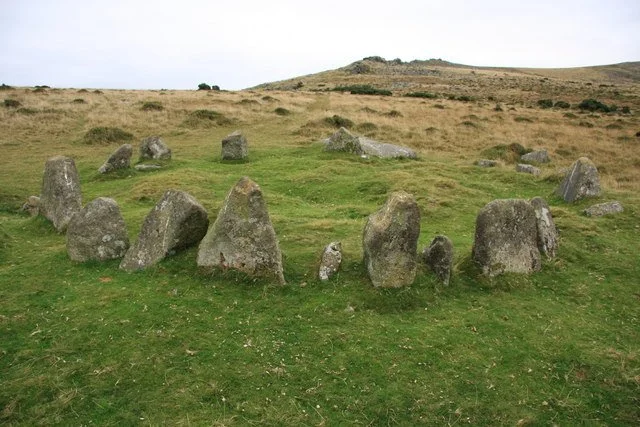
Ancient Echoes
The land of Cornwall is a tapestry where folklore is intricately woven into the very fabric of its ancient stones and rugged terrain. Chloe Eathorne talks legends and stones.
Bolster the Giant
Bolster was a giant of immense size, said to have one foot on St Agnes Beacon and the other on Carn Brea. A notorious ladies’ man, despite having a wife, Bolster became infatuated with a beautiful maiden named St Agnes. Uninterested in his advances, she devised a cunning plan to rid herself of the troublesome giant. She tricked him into thinking he could win her love by completing an impossible task.
Eager to impress, Bolster undertook the challenge. Though he tried with all his might, the task proved too great, and his hopes were dashed. In a fit of rage, Bolster began hurling massive stones across the land, each one a symbol of his frustration and defeat. When he grew old, he lay down and his body turned to stone becoming part of Carn Brea Hill.
To this day, many of the surrounding rocks are named after the giant: the Giant’s Coffin, the Giant’s Head and Giant’s Hand, the Giant’s Wheel, and the Giant’s Cradle.
In spring and summer, when the Carn comes alive with bracken and gorse, it is said that the wind carries the whispers of Bolster’s footsteps, as if the land itself still remembers this tragic tale.
Carwynnen Quoit
In a quiet field beside the lane that winds from Troon to Carwynnen, Carwynnen Quoit stands as a proud symbol of Cornwall’s rich heritage and the enduring spirit of its community. This Neolithic dolmen, affectionately known as the “Giant’s Quoit” or “Giant’s Frying Pan,” is a site of mystery and wonder, drawing visitors to reflect on its ancient history and the preservation efforts that have restored it throughout the years. Each spring, clusters of golden daffodils bloom around the dolmen, vibrant against the granite. This seasonal burst of color not only celebrates the quoit’s enduring presence but also mirrors the ongoing care and dedication of the community that continues to protect it.
The quoit’s journey through time has been shaped by a number of restoration efforts, the first of which took place in the early 19th century.
When the structure collapsed around 1815, Lady Pendarves led the initial restoration, ensuring that the dolmen remained an important landmark. In more recent years, The Sustainable Trust, led by founder the late Pip Richards, took on the responsibility of restoring it in 2009. With the support of local volunteers, archaeologists, and the community, the quoit was carefully re-erected in 2014, standing once again as a testament to Cornwall’s rich past.
Originally built during the Neolithic and Bronze Ages, Carwynnen Quoit was likely used as a burial site, where the deceased were laid to rest in a sacred space. The dolmen’s structure, consisting of a large capstone and upright stones, forms a portal tomb—a type of burial chamber used in ancient rituals. While much of the history remains unknown, it’s believed that this site played an important role in ceremonies that marked the transition from life to death, linking the living with the spiritual world.
Today, Carwynnen Quoit continues to stand as a place of reflection - a space where visitors can find a sense of peace where the land’s timeless spirit still speaks to those who take a moment to listen.
Nine Maidens
Not far from Carn Brea, nestled in the mist-cloaked hills of Four Lanes, stands the ancient Nine Maidens stone circle. These Bronze Age stones weathered by centuries, meander between the long grass, rising like silent figures of resilience.
The legend of the Nine Maidens is one woven with magic and tragedy. It is said that the stones were once nine young, beautiful women who danced beneath the moonlight in a joyous circle, their laughter echoing across the land. But their happiness did not go unnoticed. According to legend, they broke the Sabbath by dancing on a Sunday and were immediately turned to stone as punishment. Their graceful forms were frozen in time, trapped forever in their eternal dance.
Today, a semicircle of five stones remains, four of which stand tall, while the fifth is embedded in the Cornish hedge as if suspended in the very moment of their transformation.
The Nine Maidens of Four Lanes have become more than just stones; they are a living piece of Cornwall’s ancient magic, a testament to the land’s ability to hold stories that transcend time, waiting to be rediscovered by those who wander too close to the mist.


